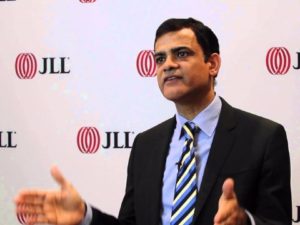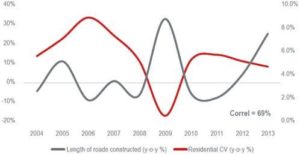By Anuj Puri

Anuj Puri – Chairman & Country Head, JLL India
“It is not wealth that built our roads but roads that built our wealth.” This line by former American president John F Kennedy holds true not only for the US but also India. Road infrastructure seems to be closely linked to residential price movements. Length of road construction is known to have a direct bearing on real estate. More importantly, it is equally vital in potentially lowering average house prices, particularly in urban areas, as can be seen in the graph below.

As road lengths increase, connectivity improves across a wider geography – thereby attracting new project launches at lower price points. This can reduce prices in urban agglomerations. If more roads are constructed in rural areas, price rise in urban cities could be restricted to moderate levels. This would help increase affordable housing projects near the metros.
Currently, the only solution to the problem of urban housing shortage in Indian cities is building new infrastructure to connect more precincts to the city centre. This theory becomes clearer when we compare the pan-India average residential price growth to the total length of road constructed in India annually which is released by the Ministry of Roads.
Not surprisingly, there was a strong inverse correlation between the two indicators. It suggests that when new roads are constructed across rural and urban areas, the spread of development happens over a wider geography. This can potentially bring down the premium that certain urban agglomerations command for having better connectivity. This could be particularly true for infrastructure-starved cities in India such as Mumbai and Bengaluru.
Fortunately, road infrastructure has emerged as a key focus area for the current government. According to media reports earlier this year, the road transport and highways ministry has set an ambitious target of laying more than 40 km of roads every day in 2016-17 – more than double the current pace. The construction target too has been set at 15,000 km against the 6,000 km constructed last year.
The Indian government plans to invest INR 3 trillion (US$ 44.73 billion) for developing 35,000 km of roads across the country, of which 21,000 km will be economic corridors and 14,000 km will be feeder routes. This is expected to improve freight movement, ease traffic bottlenecks and improve inter-city connectivity in the country. It will be interesting to watch residential property price movements in the coming years.
The author is Chairman & Country Head, JLL India
